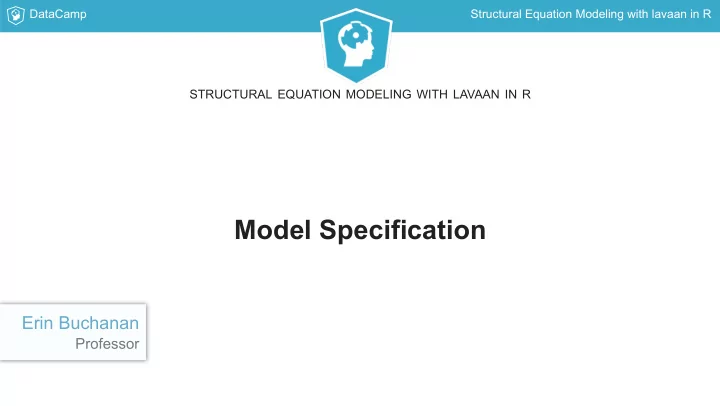

DataCamp Structural Equation Modeling with lavaan in R STRUCTURAL EQUATION MODELING WITH LAVAAN IN R Model Specification Erin Buchanan Professor
DataCamp Structural Equation Modeling with lavaan in R SEM Goals Explore the relationship between variables Confirm the structure of a developed model
DataCamp Structural Equation Modeling with lavaan in R Variables Manifest variables: Latent variables: Real numbers in your dataset Phenomenon measured by Represented by squares manifest variables Represented by circles
DataCamp Structural Equation Modeling with lavaan in R Example Model
DataCamp Structural Equation Modeling with lavaan in R Set Up Your Model library(lavaan) data(HolzingerSwineford1939) head(HolzingerSwineford1939[7:15]) x1 x2 x3 x4 x5 x6 x7 x8 x9 1 3.333333 7.75 0.375 2.333333 5.75 1.2857143 3.391304 5.75 6.361111 2 5.333333 5.25 2.125 1.666667 3.00 1.2857143 3.782609 6.25 7.916667 3 4.500000 5.25 1.875 1.000000 1.75 0.4285714 3.260870 3.90 4.416667 4 5.333333 7.75 3.000 2.666667 4.50 2.4285714 3.000000 5.30 4.861111 5 4.833333 4.75 0.875 2.666667 4.00 2.5714286 3.695652 6.30 5.916667 6 5.333333 5.00 2.250 1.000000 3.00 0.8571429 4.347826 6.65 7.500000 #an example model <- 'latent_variable =~ manifest_variable1 + manifest_variable2 + ...' #our model visual.model <- 'visual =~ x1 + x2 + x3 + x7 + x8 + x9'
DataCamp Structural Equation Modeling with lavaan in R STRUCTURAL EQUATION MODELING WITH LAVAAN IN R Let's practice!
DataCamp Structural Equation Modeling with lavaan in R STRUCTURAL EQUATION MODELING WITH LAVAAN IN R Model Analysis Erin Buchanan Professor
DataCamp Structural Equation Modeling with lavaan in R Model Terms Degrees of Freedom (df) Determined by the number of manifest variables and estimated values df = Possible Values - Estimated Values Possible Values = Manifest Variables * (Manifest Variables + 1) / 2 Identification Include at least three manifest variables Create models with df > 0 Use scaling and constraints to control df
DataCamp Structural Equation Modeling with lavaan in R Analyze the Model #model specification visual.model <- 'visual =~ x1 + x2 + x3 + x7 + x8 + x9' #model analysis visual.fit <- cfa(model = visual.model, data = HolzingerSwineford1939)
DataCamp Structural Equation Modeling with lavaan in R Summarize the Results Overall summary(visual.fit) lavaan (0.5-23.1097) converged normally after 27 iterations Number of observations 301 Estimator ML Minimum Function Test Statistic 106.553 Degrees of freedom 9 P-value (Chi-square) 0.000 Parameter Estimates: Information Expected Standard Errors Standard
DataCamp Structural Equation Modeling with lavaan in R Summarize the Results Loadings Latent Variables: Estimate Std.Err z-value P(>|z|) visual =~ x1 1.000 x2 0.586 0.139 4.215 0.000 x3 0.882 0.149 5.923 0.000 x7 0.728 0.137 5.320 0.000 x8 0.944 0.143 6.599 0.000 x9 1.205 0.170 7.095 0.000
DataCamp Structural Equation Modeling with lavaan in R Summarize the Results Variances Variances: Estimate Std.Err z-value P(>|z|) .x1 0.973 0.093 10.405 0.000 .x2 1.249 0.106 11.789 0.000 .x3 0.975 0.090 10.842 0.000 .x7 0.979 0.087 11.311 0.000 .x8 0.678 0.069 9.841 0.000 .x9 0.455 0.069 6.580 0.000 visual 0.386 0.092 4.201 0.000
DataCamp Structural Equation Modeling with lavaan in R STRUCTURAL EQUATION MODELING WITH LAVAAN IN R Let's practice!
DataCamp Structural Equation Modeling with lavaan in R STRUCTURAL EQUATION MODELING WITH LAVAAN IN R Model Assessment Erin Buchanan Professor
DataCamp Structural Equation Modeling with lavaan in R Standardized Loadings Loadings – strength of the relationship of the manifest variable(s) to the latent variable, and the standardized loadings often easiest to interpret summary(visual.fit, standardized = TRUE) Latent Variables: Estimate Std.Err z-value P(>|z|) Std.lv Std.all visual =~ x1 1.000 0.621 0.533 x2 0.586 0.139 4.215 0.000 0.364 0.310 x3 0.882 0.149 5.923 0.000 0.548 0.485 x7 0.728 0.137 5.320 0.000 0.452 0.416 x8 0.944 0.143 6.599 0.000 0.586 0.580 x9 1.205 0.170 7.095 0.000 0.748 0.742
DataCamp Structural Equation Modeling with lavaan in R Fit Indices Model Fit – how well the data fit the specified model Goodness of fit indices like the Comparative Fit Index (CFI) or the Tucker Lewis Index (TLI) Badness of fit indices like Root Mean Square Error of Approximation (RMSEA) or Standardized Root Mean Square Residual (SRMR) Measuring Model Fit
DataCamp Structural Equation Modeling with lavaan in R Fit Indices summary(visual.fit, standardized = TRUE, fit.measures = TRUE) _ _ _ User model versus baseline model: Comparative Fit Index (CFI) 0.701 Tucker-Lewis Index (TLI) 0.502 _ _ _ Root Mean Square Error of Approximation: RMSEA 0.190 90 Percent Confidence Interval 0.158 0.223 P-value RMSEA <= 0.05 0.000 Standardized Root Mean Square Residual: SRMR 0.111
DataCamp Structural Equation Modeling with lavaan in R STRUCTURAL EQUATION MODELING WITH LAVAAN IN R Let's practice!
Recommend
More recommend